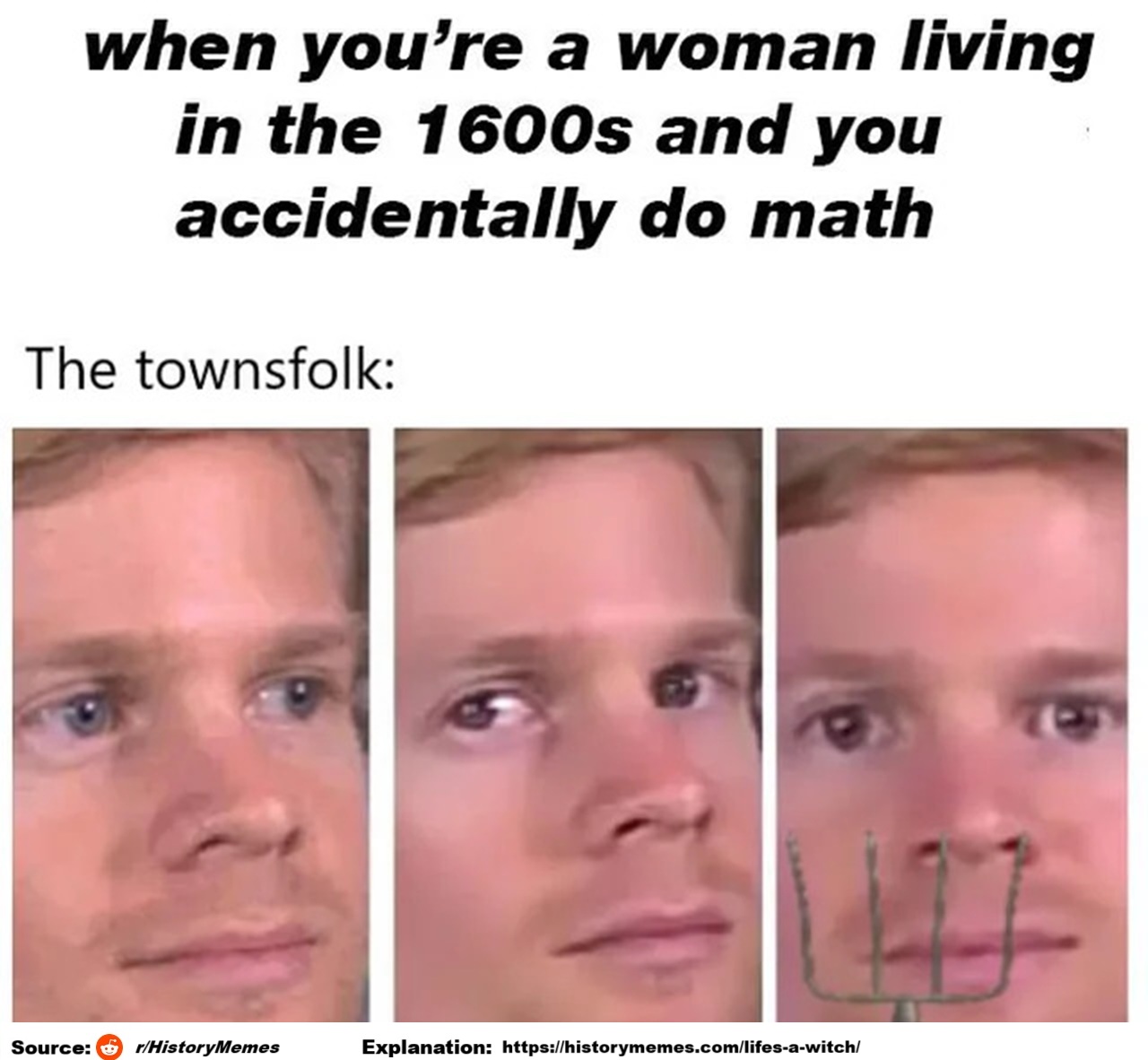
Breakdown of the meme:
- Text (“when you’re a woman living in the 1600s and you accidentally do math”)
Suggests that even something harmless and intellectual, like doing math, could be seen as suspicious or threatening if done by a woman. - Images (“the townsfolk”)
Shows a man’s increasingly alarmed expression, ending with a pitchfork, symbolizing how quickly suspicion could turn into accusations and mob justice.
Why women were often accused of witchcraft:
- Fear of the Unknown: Many people in early modern Europe (and colonial America) attributed unexplained events (crop failures, illness, storms, deaths) to supernatural causes.
- Misogyny & Gender Roles: Women, especially those who were independent, outspoken, widowed, or unmarried, were more likely to be targeted. Society expected women to be submissive, so stepping outside those bounds (through knowledge, influence, or unusual behavior) was threatening.
- Religious and Cultural Beliefs: The Bible and church authorities sometimes reinforced the idea that women were more susceptible to temptation by the devil.
- Social Scapegoating: In times of crisis (plague, famine, war), communities often looked for scapegoats. Vulnerable women were easy targets.
- Control of Knowledge: Education and intellectual pursuits, especially in fields like science, medicine, or mathematics, were considered male domains. A woman demonstrating such knowledge could be accused of sorcery.
Historical Context:
- The Salem witch trials (1692–1693) in colonial Massachusetts are the most famous example, where many women (and some men) were executed based on flimsy or false evidence.
- In Europe, witch hunts were widespread from the late 1400s to the 1700s, with tens of thousands of people executed.
So, the meme humorously exaggerates this idea: if a woman in the 1600s did something as “suspiciously clever” as math, people might jump straight to accusing her of being a witch.
Here are a few more real historical examples of women accused of witchcraft because of their knowledge or skills:
Anna Göldi (Switzerland, 1782)
- Sometimes called “the last witch in Europe.”
- She worked as a maid and was accused of poisoning a child.
- Historians believe the real reason was her knowledge of herbs and healing, combined with social prejudice against her.
- She was executed by beheading, showing how even in the late 18th century, “witchcraft” accusations still punished women who stepped outside traditional roles.
Alse Young (Connecticut, 1647)
- The first recorded witch execution in colonial America.
- Not much is known about her, but historians think she may have been targeted due to being a woman of lower social status and possibly outspoken.
- Accusations of witchcraft in Puritan New England often arose when women challenged authority or seemed to have unusual knowledge.
Katharina Henot (Cologne, Germany, 1627)
- A wealthy and influential postmaster who was accused of witchcraft.
- Likely targeted because she was a powerful woman in a male-dominated role.
- Executed despite a lack of evidence.
Midwives and Healers (Europe, 15th–17th centuries)
- Women with knowledge of medicine, herbs, and childbirth were often accused of witchcraft.
- Healing was seen as a “mystical” or dangerous activity if it wasn’t sanctioned by the Church or done by men (physicians).
- For example, a midwife whose patient died in childbirth could be accused of causing it through sorcery.
Women Who Were Educated
- In many cases, simply being literate or showing intelligence could be enough to arouse suspicion.
- Since society expected women to remain silent and domestic, stepping into intellectual or scientific fields was often equated with dangerous, “unnatural” knowledge.
Decline of Witch Hunts (Late 1600s–1700s)
Scientific Revolution & Enlightenment Thinking
- As people began to understand natural causes for disease, weather, and misfortune, there was less need to blame witches.
- Thinkers like Francis Bacon, Descartes, and Newton promoted observation, reason, and science over superstition.
- The Enlightenment encouraged skepticism of old beliefs and demanded evidence instead of fear.
Legal Reforms
- Courts started requiring better proof for accusations.
- Previously, “spectral evidence” (claims of seeing spirits, dreams, or visions) was enough to convict. Over time, judges and lawyers rejected this as unreliable.
- For example, in Salem (1692–93), after mass hysteria led to 20 executions, skepticism grew and authorities admitted mistakes.
Religious Shifts
- Early witch hunts were fuelled by intense religious conflict (Reformation, Counter-Reformation).
- By the late 1600s, Europe was stabilizing religiously, and leaders were less focused on rooting out “the Devil’s agents.”
- Many clergy began discouraging witch trials as un-Christian or barbaric.
Political & Social Changes
- Rulers realized witch hunts caused chaos and instability, distracting from state control.
- Some monarchs, like Prussia’s Frederick II (1700s), openly opposed witch trials and banned them.
- Growing central governments wanted orderly legal systems, not mob-driven trials.
Books on the subject:
- Six Women of Salem: The Untold Story of the Accused and Their Accusers in the Salem Witch Trials
- Witchcraft: A History in Thirteen Trials
- The Witch: A History of Fear, from Ancient Times to the Present
What do you think about them?
Leave a Reply